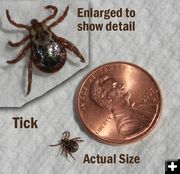Ticks are out
by Dawn Ballou, Pinedale Online!
May 3, 2009
One of the more unpleasant aspects of recreating outdoors is finding a tick on your person after getting home. These tiny bugs can transmit diseases to animals and humans, so it is important to inspect for them and remove them as soon as possible.
These tiny bugs, about 1/4 inch long, require blood meals in order to develop. They can attach themselves to clothing as people walk through grass and brush while recreating outdoors. Once on clothing, they crawl around until they find bare skin. Because they are so small and light, they can crawl across the skin without even being felt. They can easily go undetected and have time to attach and embed themselves and start sucking blood. Ticks are known to be disease carriers for Rocky Mountain Spotted Fever, Colorado Tick Fever, Tularemia (commonly known as "rabbit fever"), and Lyme Disease.
It is important to remove a tick as soon as possible after detection to minimize the transmission of diseases. Ticks like to hide, so be sure to check yourself and clothing carefully when you get back from outdoor excursions to make sure you donít have any on your body. Clothing should be put through the wash right away. Donít forget to also check pets thoroughly for the presence of ticks.
Tick season lasts from the onset of warmer weather in the spring until about mid-July when warmer weather and low relative humidity cause the ticks to become inactive.
How to remove a tick
The best way to remove a tick is with fine-pointed tweezers. Grab as closely to the skin as possible and pull straight back, using steady but gentle force.
Proper disposal of a tick
Kill the tick by stepping on it. Place the dead tick in a sealed container or small plastic bag and deposit in the trash. Do not flush live ticks down the toilet because they can easily survive in the water.

Related Links
Ticks - (Pinedale Online!)
|
|
